US Navy Uniform Profile
Commissioned Officer's Khaki Working
& Summer Aviation Uniform
(1941-1948)
Point or touch screen for explanation of images below.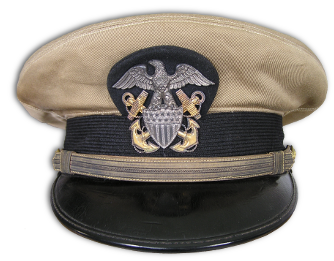
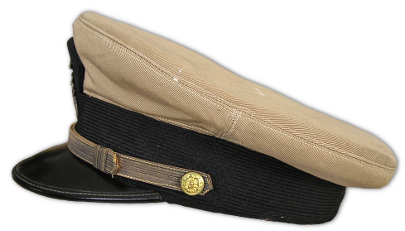
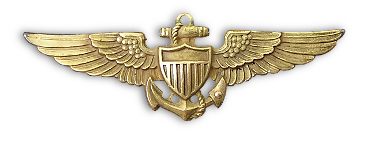
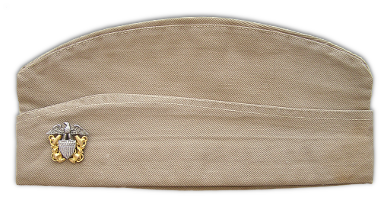
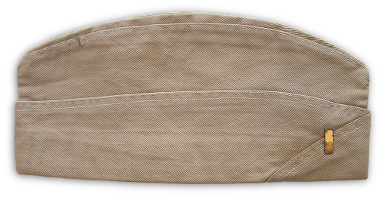
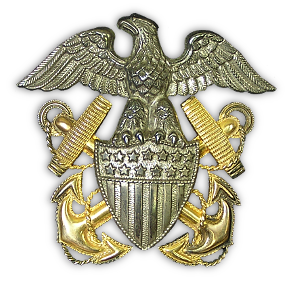
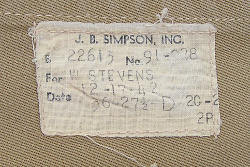
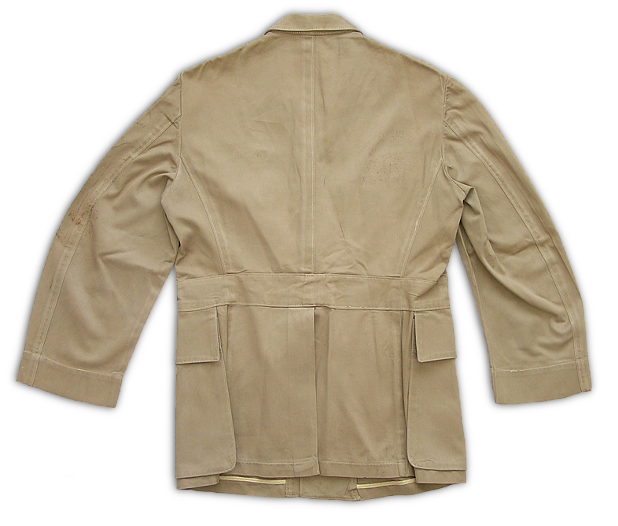
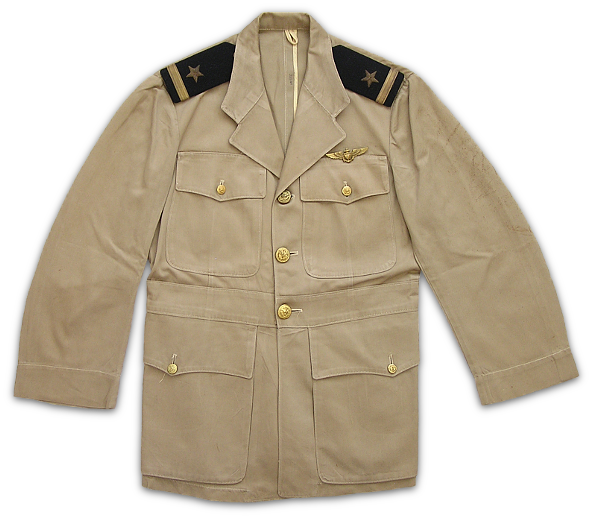
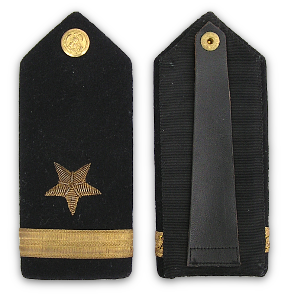

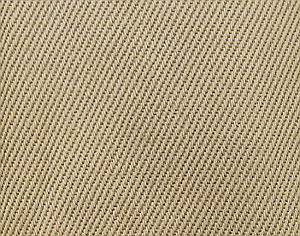
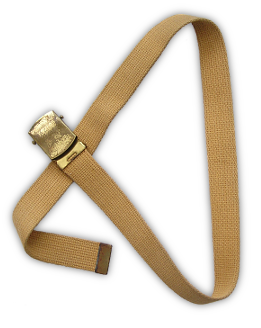
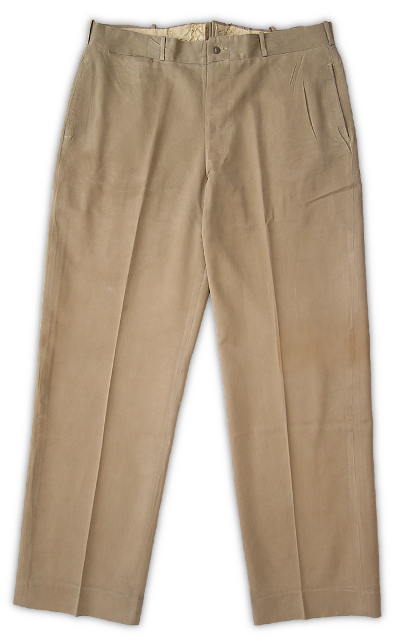
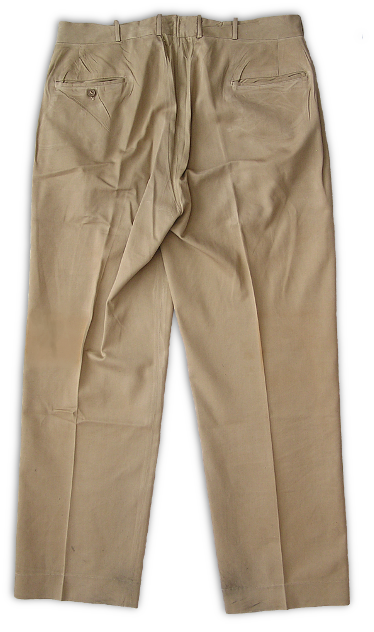
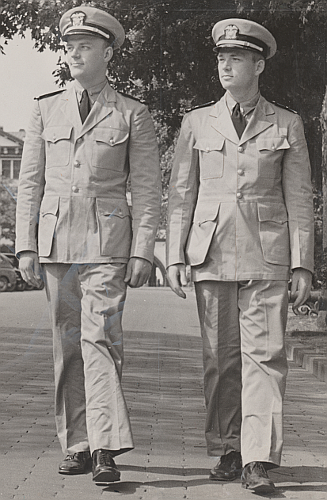
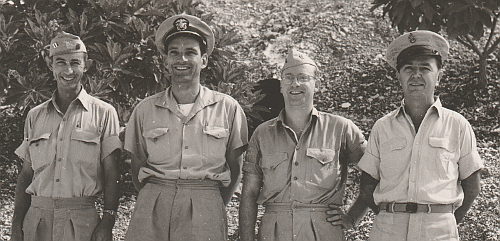
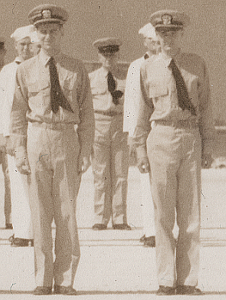
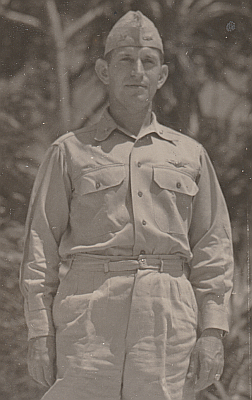
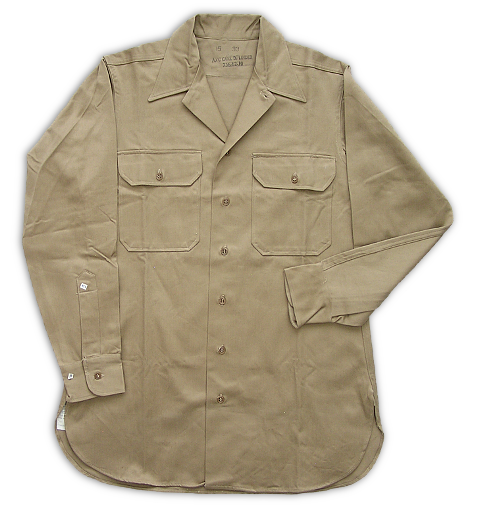

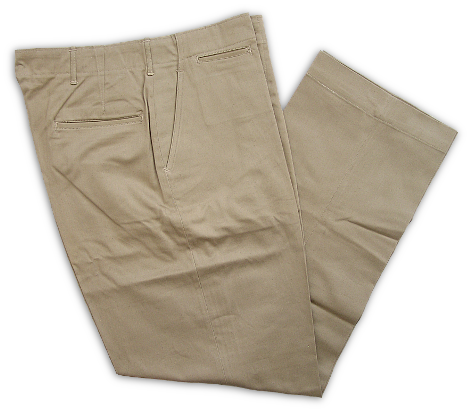
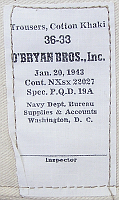
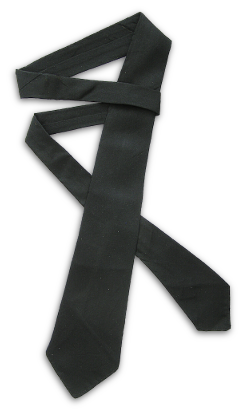
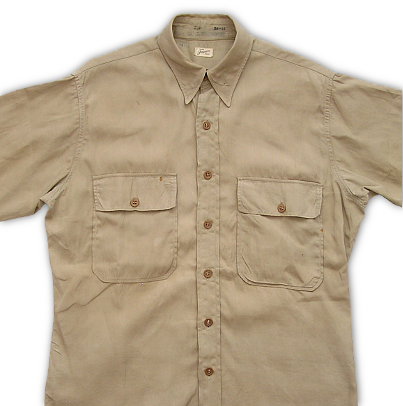
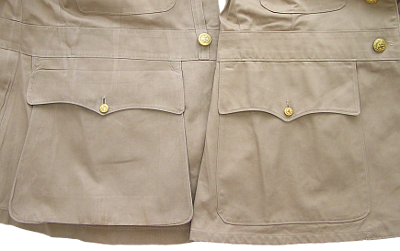
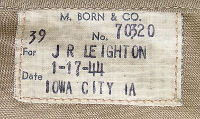
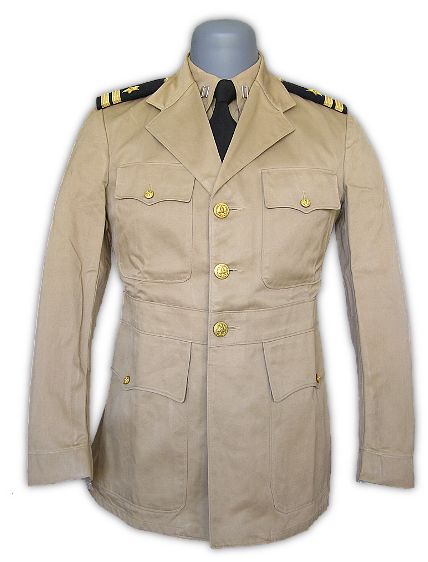
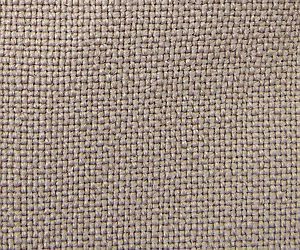
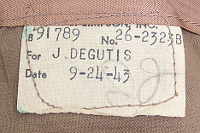
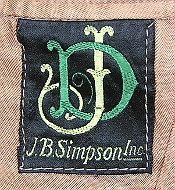
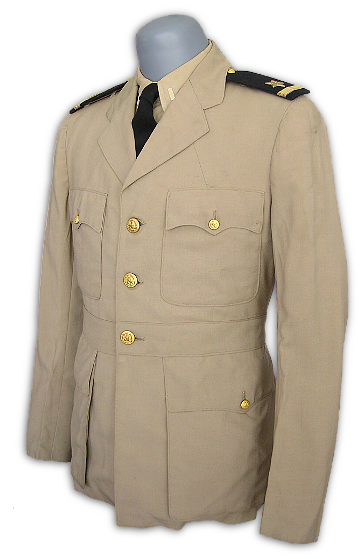
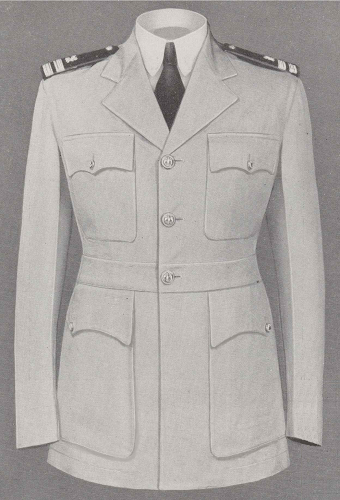
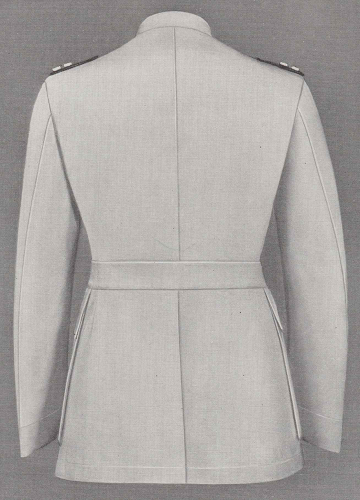
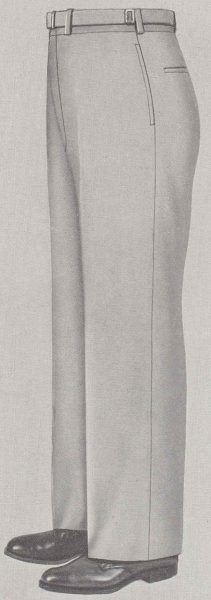
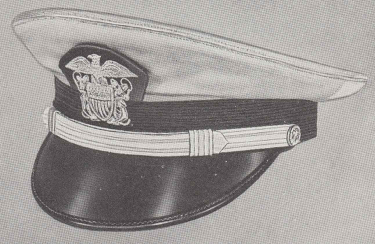
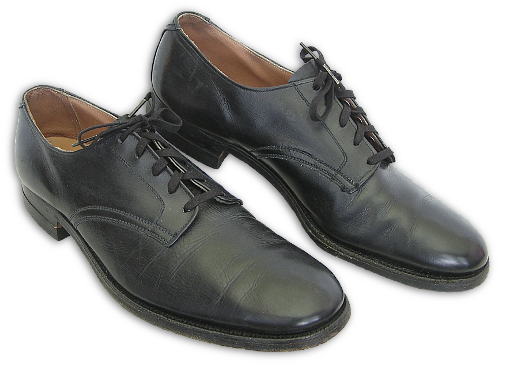
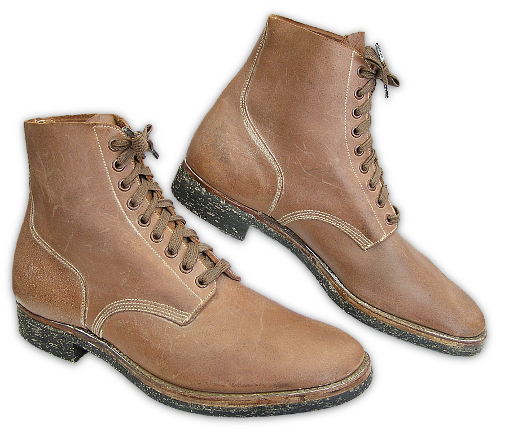
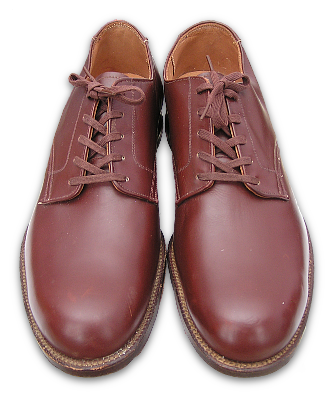
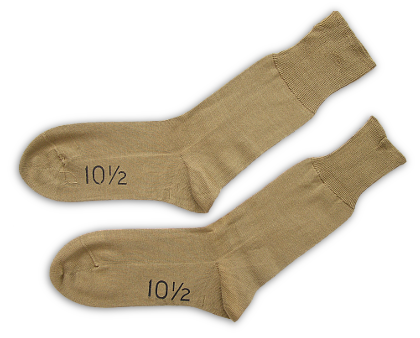
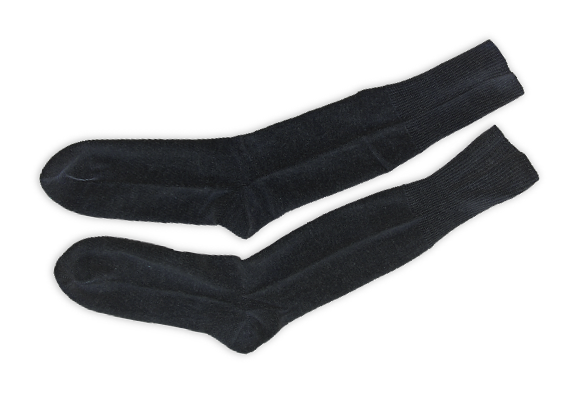
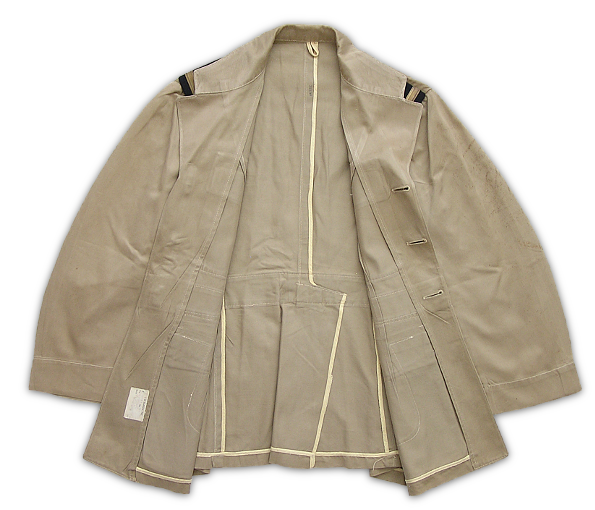
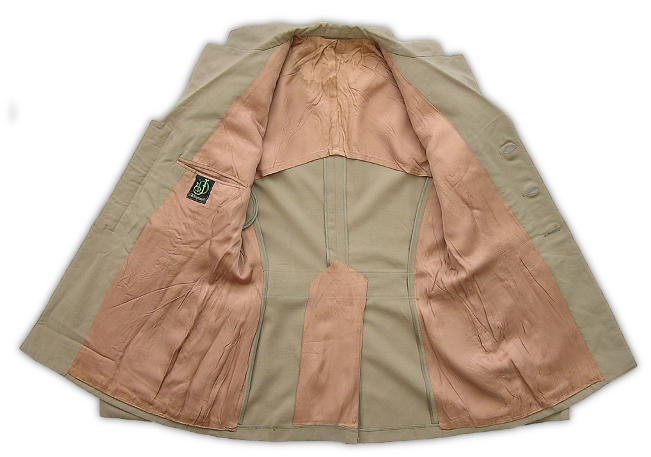
US Navy Officer's Khaki Working Uniform
Background
Prior to 1941, the khaki uniform served as the summer working uniform for naval aviators. The uniform was approved for commissioned offers, warrant officers, and CPO's and worn when flying or performing duties directly related to flying. The basic outfit consisted of a combination cap with khaki cover, khaki coat, khaki shirt, khaki trousers, and brown shoes. In the spring of 1941, the use of the khaki uniform expanded significantly when it was authorized for wear by commissioned officers, warrant officers, and CPO's throughout all branches of the Navy. The new uniform was to provide all officer's, both ashore and afloat, with a more practical and comfortable summer working uniform. Before being approved for widespread adoption, the design of the khaki coat was improved in order to make a large-scale application more practical. The pre-1941 aviator coat differed from the new design by having rank indicated by black braids around the cuff, bronze-colored buttons, and shoulder straps. All of these features were eliminated from the coat in favor of a simplified setup. Cuff rank and shoulder straps were replaced by removable black and gold shoulder marks and the bronze buttons were changed to the gilt metal type. These changes were both convenient and practical because the same shoulder marks and buttons were already in use on the mandatory officer's service dress white uniform. The main impetus behind these changes involved difficulties aviators experienced keeping the coat looking neat. Being a cotton garment it was normally laundered, but doing so often caused excessive shrinking to the rank insignia on the sleeves creating an unsightly appearance. The remedy for this problem was to have an otherwise washable khaki coat dry cleaned, which was both expensive and sometimes impractical depending on where personnel happened to be based (Bureau of Navigation Information Bulletin April 1941). In addition to the redesigned coat, officers other than those assigned to the aviation branch would wear black shoes instead of brown. The old-style khaki coat was officially replaced by the new design on 5 April 1941. However, officers already in possession of the latter type were allowed to continue wearing it until 1 January 1942 (Bureau of Navigation Circular Letter No. 73-41).
Like its predecessor, the new khaki uniform was classified as a summer working uniform and was worn when prescribed by the senior commanding officer present. In hot weather conditions, the commanding officer had the authority to allow the uniform to be worn without the coat. Initially, regulations called for the summer work uniform to be made using khaki cotton material, also known as cotton twill or cotton drill. This material, a long-time military staple recognized for its excellent durability and comfort in summer and tropical weather, shows the common characteristic of having raised diagonal ridges when examined up close. However, other fabrics were used. In the fall of 1942 the Navy allowed for the manufacture of the summer working uniform in light-weight wool, also referred to as tropical wool due to the khaki color. This type of summer-weight wool uniform was adopted by the Army, Navy, and Marines around the same time and utilized a couple of different fabric weights and weave patterns. In addition to the different outer fabric, the topical wool coat had a rayon lining whereas the cotton type was unlined. As with other Navy designs, the khaki working uniform was also used by other maritime services including the Coast Guard and Merchant Marine with the only difference being in the design of the rank insignia, cap insignia, and buttons used thereon. In late 1942 through early 1943, the role of the khaki working uniform would come under review as was the case with most other uniforms across all branches of service. During this time emphasis was put on the development and production of modern combat uniforms and shifted away from traditional dress and service uniforms.
In the summer of 1942, the Navy was looking into replacing the khaki working uniform. This program was mainly concerned with the color of the uniform and was focused on bringing it into current military convention by interjecting the concept of camouflage into the design. As a result, in April 1943, a slate gray color was approved for use as the basis of a new officer's cotton summer working uniform. This uniform was mainly intended to provide a measure of concealment for men afloat where the new color blended with the paint scheme of ships. During this time a host of other Navy uniforms were also upgraded both in design and color. In addition, some completely new types were introduced. For example, improved olive drab versions of Special Winter Clothing replaced the old blue cold weather outfits. In early 1943, olive drab herringbone twill uniforms of both one and two-piece designs were added into the mix. The adoption of these uniforms would have a direct impact on the status of khaki uniforms in general. Developed in 1941 by the Army and Marine Corps as improved chore uniforms, herringbone twill uniforms were found to be readily adaptable to the hot and tropical weather combat role and a notable improvement over khaki uniforms previously used for this purpose. In late-1942, the Navy adopted modified Army herringbone twill designs for use by ground forces stationed at overseas bases and other forward areas. With the emergence of the herringbone twill uniform, the khaki uniform, which had traditionally served as a dual-purpose garrison and field uniform, was now viewed by all branches of the military as primarily a garrison uniform more suited for wear in rear areas.
The new gray working uniform was essentially the same as the khaki version with the exception of a couple of minor design changes made to the coat. In addition to the color, the gray coat differed from its khaki predecessor by doing away with the expanding pleat lower pocket in favor of a simple patch type, buttons would be made of black plastic instead of gilt metal, and the shoulder marks would be changed to a flexible design with black insignia on a gray background. Though the intention was to replace the khaki uniform with the gray this was never fully accomplished during the war. The reason for this involved the difficulties of procuring and supplying uniforms in a time of both war and rapid military expansion, which inevitably resulted in never-ending shortages requiring the need to conserve materials as much as possible. With this in mind, the Navy allowed officers to wear out their current khaki uniforms before being required to dress in gray and also allowed current stockpiles of khaki uniforms and material to be used up. Furthermore, the supply of cotton twill fabric came under pressure in 1943 because of the urgent need to produce combat uniforms that relied upon the same fabric. This created a longer than anticipated time frame to acquire the gray cotton twill to complete the uniform changeover. The 1941 Navy Uniform Regulations were modified effective 1 October 1943 to show the gray uniform as the official officer's working uniform (as reported by the 15 June 1943 issue of the Navy Department Semi-Monthly Bulletin). This proclamation was qualified with the following footnote: "Gray uniforms will be worn when available. During the necessary transition period, officers will be permitted to wear khaki uniforms, now in their possession or manufactured, until the supply in stock is exhausted." This message was again reiterated in the 2 July 1943 Circular Letter from the Secretary of the Navy, only this time the message was slightly modified: "Gray working uniforms of the same materials now used will be worn when available. During the necessary transition period officers will be permitted to wear khaki uniforms, now in their possession or manufactured until the supply of these uniforms in stock is exhausted or those in possession are worn out." As of the writing of this article, efforts to locate a specific wear-out date for the khaki uniform in primary source material proved unsuccessful. In fact, surviving uniform examples suggest that khaki working uniforms were being purchased and worn through the end of the War as evidenced by the dates shown on the tailor's labels within. One such example, dated 1944, is shown in the feature above to help illustrate this. Thus, it should be noted that although uniform regulations were changed and various circulars and bulletins were released giving the gray uniform preeminent status over the khaki, reality suggests that this position was never fully achieved. In addition to surviving uniforms, photographic evidence appears to support this as well. Period photos seem to show that although the gray uniform became increasingly common as the war progressed, the khaki type remained prevalent, especially among men ashore. In the Pacific Theater of Operations, where warm to hot weather conditions prevailed, the khaki uniform was mostly worn without the coat and consisted of trousers, long-sleeve shirt open at the collar, and either a garrison or service cap.
Caps
Two different styles of caps were authorized for wear with the khaki working uniform. The first was officially known as a combination cap, which was a peaked visor cap consisting of a frame and a set of changeable covers designed to match the color of the uniform being worn. Officer's combination caps are distinguished by having a black, braided mohair band with a semi-circular backing in front to which a cap device was attached. The commissioned officer's cap device consisted of a silver eagle clutching the US shield superimposed on a set of crossed fouled anchors in gold. This emblem could be either a metal badge attached by post and nut to the backing or be embroidered directly onto the backing. Officer's visor caps were also trimmed with a gold lace chinstrap held in place by a set of matching gilt buttons. The second kind of cap authorized for wear with the khaki working uniform was a light, foldable, envelope type cap called a garrison cap or overseas cap. Garrison caps were first authorized for wear in early 1941 with the naval aviator's winter and summer working uniforms. Then at the beginning of 1943, garrison caps were made optional wear for officers in all branches of the Navy. Rank insignia was to be worn on the right, front part of the garrison cap and a miniature commissioned officer's cap device on the left, front. Naval aviator's wore miniature wings on the left, front until the spring of 1943 when this was switched to the miniature commissioned officer's cap device (BuPers Circular Letter 51-43).
Coat
The khaki coat was single-breasted with a roll collar and notched lapels. To fasten the front there were three 35-line buttons made in gilt metal, which bore the traditional Navy emblem of an eagle clutching an anchor surrounded by 13 stars. There were four outside pockets, each with flaps, and closed with 22½-line gilt buttons. The lower pockets were notable for being generously sized. They extended from the beltline to the bottom of the skirt and were 9½ inches wide at the top and 12½ inches wide at the bottom. They also had a bellows pleat further enhancing carrying capacity. A two-inch wide cloth belt was sewn around the midsection of the coat and was a distinctive feature of officer's working coats. For easy laundering, all buttons on the coat were removable. The button shank was passed through a small stitched grommet and then secured with either a metal retaining ring or cotter type pin attached to the button eyelet. The coat had two cloth loops on each shoulder to which rank insignia was attached. Shoulder marks were the black and gold type traditionally worn on the officer's white uniform. The length of the coat was to extend to the crotch or a little lower. Fitting was to be easy with plenty of room in the back to allow the arms to extend in any direction. An optional shoulder pleat or bi-swing back was allowed by regulation. A rear vent extended from the skirt up to the beltline enabling easy bending and stooping. Navy uniform regulations called for the coat to have an inside breast pocket on each side of the coat. However, most cotton coats made during the WW2 era seem to lack this feature altogether or have only one inside pocket at the most. In mid-1943, the pattern of the cotton working coat was altered with the introduction of the gray uniform wherein the bellows feature on the lower pockets was eliminated. As a result, khaki coats manufactured after the pattern change can exhibit the same patch type lower pockets specified for the gray coat.
Trousers
Navy officer's working trousers of the WW2 period were a simple design that allowed plenty of room in the hips and rear for bending and stooping. The 1941 uniform regulations specified that the bottom of the legs be between 18 and 22 inches in circumference and that the material match the coat. These trousers had a button fly, two front internally hung pockets, two rear internally hung pockets, and a watch pocket just below the waistband on the right, front. Unlike similar Army and Marine Corps officer's types, the Navy trousers did not have rear pocket flaps. However, the left, rear pocket did have a button-through closure. Early in 1943, the Navy began procuring khaki trousers built to Army specifications. These trousers helped fill the need for hot weather working uniforms (essentially the khaki working uniform minus the coat) that would meet Navy requirements while at the same time help to ease the burden on the overtaxed garment industry by enabling it to concentrate production on a single pattern of trousers that could be utilized by both branches of service. The design of the Army trousers was very similar to the conventional Navy type except for having canted front pocket openings, a simplified waistband, and the lack of a closure button on the rear pocket. Army type khaki trousers procured by the Navy usually had a contractor's label located behind the front, right pocket stating the name of the manufacturer, specification number, contract number and date, etc. Though great numbers of Army type trousers were procured, most Navy khaki trousers encountered were built to the pre-war Navy specifications and were purchased by officers from commercial retailers as part of the complete khaki working uniform requirement. A khaki-colored web belt about 1⅛ to 1¼ inches wide with a gilded brass sliding buckle was typically worn with the trousers.
Shirts
The conventional pre-war khaki shirt was designed with long sleeves, a stand-up collar, a dress shirt style front button placket, two chest pockets with flaps that came to a gradual peak, and was made of traditional cotton twill material. A black four-in-hand necktie was worn with the shirt and could be made of silk, wool, rayon, or other synthetic materials. During WW2, the design of the traditional Navy khaki shirt diverged greatly from the pre-war type described above. Like in the case of the khaki trousers mentioned above, beginning in January 1943, the Navy began to procure Army type khaki shirts. The Army khaki shirt of this period was a convertible collar design, which allowed it to be worn as an open collar field shirt in hot weather, or it could be worn as a closed collar dress shirt if the occasion required. Aside from the different collar design, the Army shirt is distinguishable from the traditional Navy design by having a plain front placket and squared pocket flaps with clipped corners. Procuring Army style shirts helped the garment industry to produce more shirts by reducing the number of different designs it would otherwise need to produce. Army style shirts procured by the Navy generally had a contract label located on the lower right shirttail seam stating the manufacturer's name, specification type, contract number and date, etc. As time went on, a wide array of shirts ended up in use. There were the pre-war traditional types, the Army clones, as well as shirts that combined designed elements from both of these types. Navy officers also wore USMC cotton khaki shirts and commercial variants of these shirts. Additionally, some khaki shirts were made in alternate fabrics, such as cotton poplin. Occasionally some period photos will even show Navy officers wearing shirts that had shoulder straps - a feature distinctive of Army officer's shirts and one that was always conspicuously absent from the traditional Navy design.
Shoes
In 1941, when khakis were approved for officers in all branches of the Navy, the plain low black shoe became the standard for wear with the uniform. Regulation Navy shoes could either be high or low, were made in black chrome calfskin, had a Goodyear welt leather sole, a plain toe, and followed a blucher pattern. The brown shoe remained an option during the War years but became in short supply as demand required production to be focused on the standard low black shoe and the new field shoe. Introduced in 1941, the ankle height field shoe was made of natural rough-out leather and was intended for overseas use by men assigned to construction battalions, ordnance units, forward base installations, and the like. In the Pacific Theater of Operations where Navy shore personnel manned numerous bases across the island chains, the field shoe was commonly worn with the khaki uniform. Later, in 1943, this shoe was designated the N-1 Field Shoe. Socks were black when worn with the standard Navy high or low black shoes and brown or tan when worn the same type of brown shoes. A more robust sock with cushion soles and reinforced heels and toes was developed for wear with the brown field shoe. This sock came in either olive drab or gray and consisted of roughly a 50/50 mixture of cotton and wool.
Conclusion
Though not known for its glamorous appearance or daring exploits, the story of the Navy's cotton khaki working uniform is in no way mundane or unimportant. In fact, in the decade from 1941 to 1950 the uniform was at the forefront of change. First, early in 1941, it was declared the standard working uniform for officers; next, in 1942, a spin off wool cousin came into being; then, in 1943, it survived an attempt to replace it with a similar gray version while also having its role limited; and eventually, in 1947, its role was officially changed after being reclassified from a working uniform to a service dress uniform. Despite having never been fully supplanted by the gray uniform during the War years, on 15 May 1946 Navy officials once again gave officers permission to purchase new khaki working uniforms (Alnav 211-46). Thus, at this time both the khaki and gray work uniforms were declared optional, meaning an officer could choose to wear one type or the other. In the meantime, experience gleaned through the war led the Navy to re-evaluate the khaki working uniform as a concept. It was felt that the khaki cotton coat was too uncomfortable for wear in tropical and hot weather and was either not worn or removed when such conditions were encountered. As a result, the Navy decided to eliminate the khaki cotton coat from the summer working uniform. This was a decision that the Army and Marine Corps had already made based on their pre-war experiences in South America, China, and the Philippines and was implemented for enlisted men before the War began and then repeated for officers during the early stages of WW2. Early in the post-war era, the Navy would officially adopt a three-tier system for the Khaki uniform consisting of a Summer Service Uniform, a Summer Working Uniform, and a Tropical Uniform. Although this system didn't become official until after the War, it had first evolved by a matter of practical application during the War years. Not long after announcing that the khaki uniform could be purchased again, the Navy followed up by announcing that the khaki uniform would, once again, be the official Navy working uniform and gave a wear out date for the gray uniform of 15 October 1948 (Alnav 406-46). At this same time, the Navy explained that the old Khaki Working Uniform would be re-designated as the Summer Service Uniform and the official fabric would change from the traditional cotton twill to tropical worsted wool, wool gabardine, Palm Beach type, or rayon gabardine. It was also announced that the khaki cotton shirt and trouser combination would become the new Khaki Working Uniform. The coat for the new Summer Service Uniform would retain the patch type lower pockets that had been instituted when the gray coat was adopted. Officer's already possessing khaki coats with the bellows pockets would be allowed to continue wearing them until they were no longer serviceable. The last type of khaki uniform was called the Khaki Tropical Uniform and was a holdover from WW2. It consisted of a short sleeve, open collar, khaki cotton shirt; matching knee-length shorts; and a cap or fiber helmet. The final date given for these changes to be fully implemented was 15 October 1948. However, limited use of the gray coat was extended for another year for officers afloat. The changes discussed above remained in place well into the 1950's and for the purpose of this uniform profile closes the chapter on one of the classic Navy uniforms of the WW2 period. Khaki uniforms were widespread across the different branches of the military during WW2 and were well-liked. After the War, the relaxed fit and casual but sensible appearance of the trousers translated well into the civilian clothing market where they've remained popular and essentially unchanged for over 80 years.